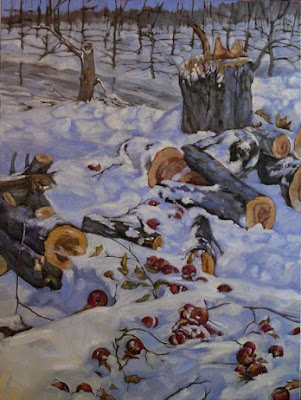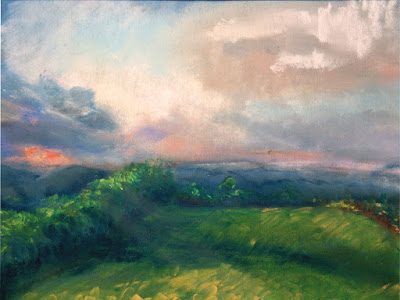There’s a world of difference between copying a photo and creating a painting using photos for reference.
 |
| Skylarking 2, 18×24, $1855 unframed. It’s difficult to paint boats under sail en plein air, so mostly we use photographs for that. |
It is not true that I never paint from photos; I just prefer painting from life. However, there are times (winter) and subjects (boats under sail, babies) that lend themselves to painting from photographs. Size is also a limiting factor; nobody can finish a painting much larger than 40×40 in the field without two stout oafs to stabilize the canvas.
What I don’t do is slavishly follow a single photo. Instead, most of my studio paintings are compilations of images.
 |
| All flesh is as grass, oil on linen, 36×48, $6231 framed. |
Start with an idea. Let us say, for example, that you want to paint the “season of mists and mellow fruitfulness/Close bosom-friend of the maturing sun,” as John Keats put it. Symbols of that idea might include apple orchards, golden light, morning fog over the blueberry barrens.
Gather photos, from your own stash. I have tens of thousands of reference photos on my server; you probably have a few thousand on your phone alone.
Think of this step as similar to the interior decorator’s design board or a Pinterest board. Your goal is not to find a photo you’ll ‘paint from,’ but to find ideas you want to incorporate into your painting. I do this on my laptop (as most of you probably will) but there’s no reason it can’t be done the old-fashioned way, on a bulletin board.
After allowing these images time to percolate, identify the major motif of your painting. That’s its focal point. Then, do a sketch balanced around that motif. It’s helpful to set your reference material aside at this point, and let the sketch bubble up from your subconscious. If that doesn’t work for you, think about compositional armatures. Place your focal point accordingly, and work out from there.
Then it’s simply a matter of borrowing a bit from here, a bit from there, until you have a coherent, cohesive sketch.
Do not simply trace or grid a photo and expect to get a good painting from it. The whole point of painting is to allow room for your subconscious mind to enter the dialogue. You should be drawing from your photo until you have a powerful picture, then building on that drawing in your painting. If you can’t draw well enough to do this, then you need to improve your drawing skills, stat!
|
Vineyard, 30X40, oil on canvas, $5072 framed. This started life as the field painting below, and was painted again in the studio using the process outlined in this post. |
Other than for animals or glaciers, extreme telephoto lenses are not great for reference photos. They create pincushion distortion that can seriously muck up a drawing. Cell phones have wide-angle lenses. These create different problems, but they’re easier to correct in the drawing phase.
When I take photos for reference, I always leave in more background than I would have if I were shooting for the photo’s sake. I can always crop later, but there’s no way to add back in the missing information if I decide I need it.
Never try to replicate the out-of-focus background of a photo with a shallow depth-of-field. That’s not how human perception works, and it’s a dead giveaway that you simply copied a photo, rather than created a picture using reference photos.
 |
| Vineyard, 9×12, courtesy private collection |
Try to keep the lighting the same in all your reference photos. In general, it’s wise to avoid high-contrast pictures for painting. When whites are bleached out and darks are black, we lose all the information that might have been in those passages, and they inexorably lead us to paint in excessive contrast.
While I use my own photos almost all the time, there are times when I use photos from the internet. It makes no sense for me to hunt down a Friendship sloop to check its rigging when the information is right there in someone else’s photo. It goes without saying that you shouldn’t be copying substantive portions of other people’s work without permission. However, you can use the internet for research into how a shoe might reflect light, or the color of cornflowers, or what the mist looks like in an orchard in April.








